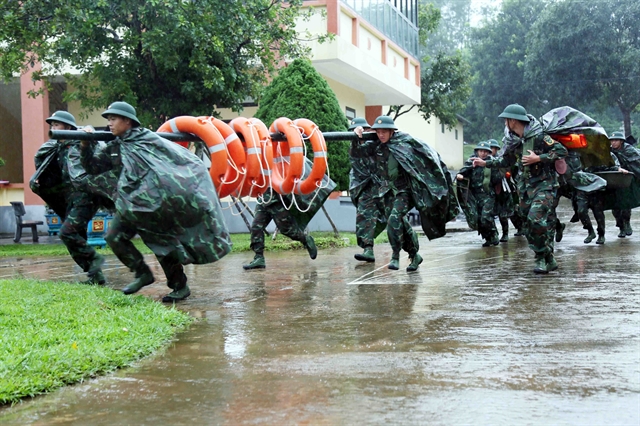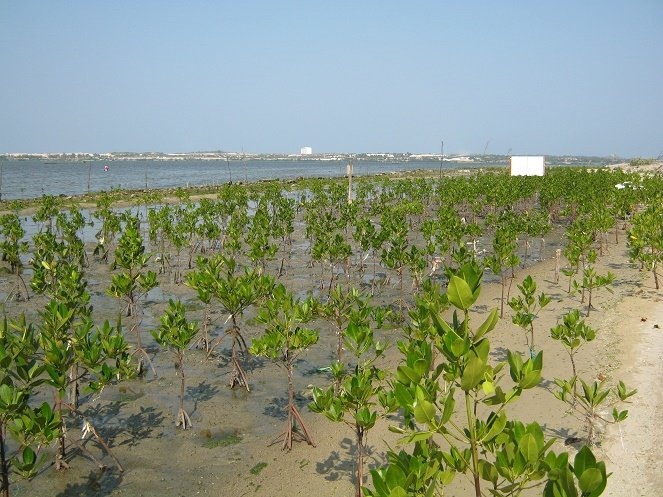 Society
Society

As hot weather peaks this month in southern Việt Nam, authorities in the Cửu Long (Mekong Delta) region are stepping up efforts to cope with forest fires and salinisation as a response to climate change.
 |
| As hot weather peaks this month in southern Việt Nam, authorities in the Cửu Long (Mekong Delta) region are stepping up efforts to cope with forest fires and salinisation as a response to climate change. –Photo dmhcc.gov.vn |
By Văn Châu
MEKONG DELTA – As hot weather peaks this month in southern Việt Nam, authorities in the Cửu Long (Mekong Delta) region are stepping up efforts to cope with forest fires and salinisation as a response to climate change.
The Delta’s Kiên Giang Province alone has 86,450ha of forested land, accounting for 13.6 per cent of its total area.
“As one of the vulnerable areas for forest fires in the dry season, U Minh Thượng National Park (UMTNP) in Kiên Giang Province is now our biggest concern,” said Lê Văn Trọng, a member of the management board at the park.
“Fire prevention may be easier this year than in 2017 because the park has had few heavy rains in the first two months of the year. The water level is still high in small rivers and lakes in the park,” he added.
Of the park’s total area of 21,000 hectares, 8,000 hectares comprise a core area which houses many rare and endangered birds. A total of 187 bird species, 39 amphibian species and 34 fish species live in the park.
The forest is widely considered the Delta’s richest region in terms of plant and animal life, with over 243 species of plants. The park has a rich mammalian population, totaling an impressive 32 species, which includes hairy-nosed otters and fishing cats.
“Despite this season’s more favorable conditions, the water level at higher parts of the park has fallen quickly since the beginning of the month, so the threat of forest fire is high in that area in particular,” Trọng said.
To solve the water shortage, rangers, soldiers and locals are digging pits to store water capable of containing about 200 m3 of water each, he added.
For key areas at a high risk of fire, rangers and forest owners have been told to mobilise forces and equipment for fire prevention and fighting around the clock during the dry season.
Rangers, soldiers and locals will also be asked to offer assistance in case of fire.
The provincial government has spent more than VNĐ10 billion (US$440,000) for forest fire prevention this year.
Provincial and district forest protection agencies have been asked to work with local authorities to regularly inspect, patrol and strictly manage forest areas to detect violations in a timely manner.
Huỳnh Minh Nguyên, director of UMTNP, said that rangers at watch towers were monitoring the park around the clock.
“The force also regularly patrols the park to prevent locals from entering it illegally to collect honey, or to hunt and fish.
“The canopy is thick and like a tinderbox," he said.
He added that the UMTNP management board had called on local households to take part in forest management and use preventive measures against fire.
“Apart from this, forest management agencies have been asked to adapt to climate change in the dry season so they can raise awareness about forest protection among local households and train them in proper fire prevention measures when they do daily chores like cooking, collecting honey, or burning dried leaves and dried straw after crops,” Nguyên said.
Trương Thanh Hào, head of the local Forest Protection Sub-department, said that provincial authorities had instructed local forest rangers, the police, and the army to work closely to prevent fires.
Temporary dams and wells have also been built in forests to store water. In addition to clearing dried branches and bushes in forests, firebreaks have been installed.
Saltwater threats
Because water flow from the Mekong River began to reduce rapidly early this month, saltwater is predicted to enter local rivers more deeply in Delta provinces during the dry season, according to the Southern Institute of Water Resources Research (SIWRR).
In 2010, saltwater began appearing two months earlier than usual and spread more widely and deeply into the major tributary rivers of the Mekong River in the western area, including the Tiền, Hậu and Vàm Cỏ rivers.
Salinity in the early dry season has been unusually bad. As a result, local authorities and farmers have been told to restructure agricultural and aquaculture production to adapt to climate change.
Saltwater is predicted to enter 25 to 35 kilometers at local river gates in Delta provinces, including the Vàm Cỏ River, in the dry season, threatening local water sources.
Water levels in canals have been low since the end of last month, causing saltwater to encroach deep inland.
In Kiên Giang Province’s Kiên Lương District, saltwater has penetrated 15km into the Rạch Giá-Hà Tiên Canal and Canal 15.
In Tiền Giang Province, saltwater has intruded 20km inland and is expected to surge 30-40km by the middle of this month.
The water has a salinity of about four per cent, which is believed to be harmful to crops and expected to enter Bến Lức and Tân An areas in Long An Province.
SIWRR has told local authorities and farmers to store water and have a plan to combat salinisation in the dry season.
The Water Resource Directorate at the Ministry of Agriculture and Rural Development is regularly updating information on salinisation and water sources so local authorities can develop plans to cope with climate change.
Local authorities have also been told to monitor salinity at all times and inform farmers about the status, as well as give instructions in restructuring their agriculture and aquaculture production.
The delta provinces of Kiên Giang, Sóc Trăng, Bạc Liêu and Cà Mau have been hit the hardest by saltwater intrusion.
Farmers in Kiên Lương, An Biên, An Minh, Vĩnh Thuận and U Minh Thượng districts in Kiên Giang tried and failed to save standing rice crops last year.
Solutions
To give farmers up-to-the-minute data about salinity, Cần Thơ City since 2012 has set up eight automatic salinity monitors on main rivers and canals in the city.
Bạc Liêu Province has seen hot weather and saline conditions recently. Together with the neighbouring provinces of Cà Mau and Sóc Trăng, Bạc Liêu is now operating 100 major sluices to adjust the usage level of fresh water. Farmers have been warned to preserve fresh water.
Last year, more than 40 temporary dykes were built in the three provinces.
In an attempt to prevent saline intrusion and preserve soil quality, the entire region is now planting two rice crops each year, instead of three. The extra time is being used to grow vegetables.
Last year, Kiên Giang took precautionary measures by investing more than VNĐ40 billion (US$1.8 million) to upgrade 276 dykes and build sluices on the Kiên River and Cụt Canal.
Another VNĐ20 billion ($900,000) was spent on drilling more wells to ensure fresh water for domestic use.
The Tiền Giang Province’s People’s Committee has instructed relevant agencies to apprise locals about saltwater intrusion.
It has also instructed authorities in coastal districts to dredge canals to store fresh water and pump fresh water for rice fields if saltwater intrusion worsens.
New sea-dyke would help Mekong Delta cope with climate change
Experts and representatives from the Government and international organisations met yesterday in HCM City to discuss the feasibility of a sea-dyke project which could help the Cửu Long (Mekong) Delta cope with the effects of climate change.
Speaking at the workshop, Nguyễn Duy Tuấn, director of the Institute of Geology, Water and Environment, said that responding to climate change, especially in the Mekong Delta, was a top national priority.
“It’s vital to invest in new structures to prevent tides and saline intrusion. We also need to store fresh water and respond to rising sea levels in the Mekong Delta, as well as cope with flooding in HCM City,” he said.
The project, which was proposed in 2011 by the Ministry of Agriculture and Rural Development, would include a 28km-long dyke extending from Gò Công Commune to Vũng Tàu City and Cần Giờ Biosphere Reserve, where it would connect with another dyke 13km long.
The proposal also includes construction of drainage ditches, a Lòng Tàu sluice, and Đồng Tranh estuary dams and canals north of the Soài Rạp River.
Scientists have completed a pre-feasibility study for the project, which has met the requirements of HCM City and Mekong Delta provinces.
To set up a scientific basis for the construction of Vũng Tàu - Gò Công sea dykes, the Ministry of Science and Technology has carried out six independent scientific research projects at the state level.
Prof. Dr. Đào Xuân Học, chairman of the Việt Nam Irrigation Association, said the sea-dyke project would offer a solution to flooding caused by a combination of heavy rains and tides.
It would also address salinity intrusion and rising sea levels for 1.1 million hectares.
“It is recommended that the project be implemented in three phases with a total investment of VNĐ74 trillion (US$3.24 billion),” he said.
Dr. Lê Xuân Tuấn of Hà Nội University of Natural Resources and Environment said it was important to continue to assess floods, tides and mangrove forests and other natural phenomena west of Lòng Tàu River and east of Soài Rạp River.
He explained that the assessment would serve as a basis for a more detailed assessment of the impact of the Vũng Tàu – Gò Công sea dyke construction on the area’s ecosystem, especially on mangroves and benthic animals.
Experts at the workshop also discussed the impact of the project on social and economic development of localities, as well as the development of waterway transport in the region.
The workshop was organised by the Institute of Geology, Water and Environment, Việt Nam Irrigation Association, Việt Nam Hydrological Association and the Hoàng Gia Water and Environment joint-stock company. — VNS




.jpg)